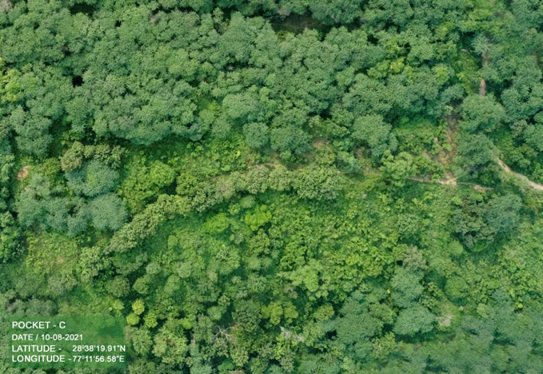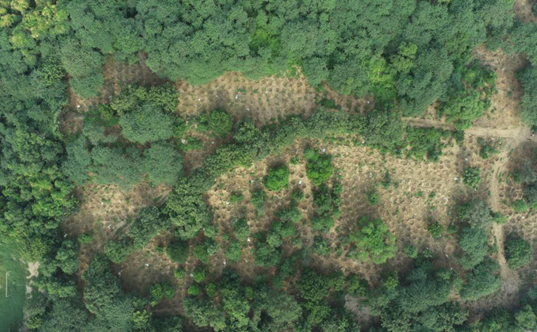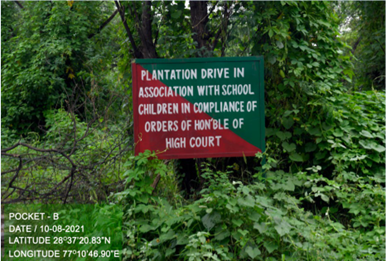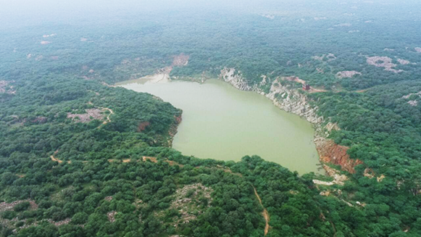An Endeavour To Replenish The 'Green Necklace' Of The National Capital
Naman Garg
5 Jun 2022 2:35 PM IST
"Never say there is nothing beautiful in the world anymore. There is always something to make you wonder in the shape of a tree, the trembling of a leaf."[1]It is often said that the legacy we leave behind in the form of selfless actions is the true meaning of life, as is to plant trees under whose shade we do not expect to sit. Anyone who has been fortunate enough to share proximity...
"Never say there is nothing beautiful in the world anymore. There is always something to make you wonder in the shape of a tree, the trembling of a leaf."
[1]It is often said that the legacy we leave behind in the form of selfless actions is the true meaning of life, as is to plant trees under whose shade we do not expect to sit. Anyone who has been fortunate enough to share proximity to nature would relate to the famous novelist Emily Bronte when she says "Every leaf speaks bliss to me, fluttering from the autumn tree".
Cities all around the globe are looking to harness trees as they can remarkably help in reducing urban air pollution. New York once struggling with pollution got to grip with the air pollution by planting around 1.3 million trees.[2] There is no iota of doubt that the land locked city of Delhi is considered one among the most polluted cities in the world. Considering the air quality in Delhi in the past few years, calling it a gas chamber would be no exaggeration.
A single bench of the Delhi High Court over the past few years has been working rigorously to replenish the 'green necklace' of Delhi. As of May 2022, the bench has imposed cost in a total of 386 cases in approximately past four years out of which 105 cases are from the year 2022. Such costs imposed have been used for plantation of a grand total of 2,50,056 trees which include trees ordered to be planted by this Court and the Departmental plantation upon orders of this Court. The Court takes due care that this drive of extensive plantation at the expense of the parties to different litigations do not get wasted for want of proper care and nurturing. It has on various occasions expressed its concern over the 'self defeating exercise' of cutting down fully grown trees by the Forest Department instead of transplanting such trees. It strictly directed that there should be no felling of trees in the city henceforth.
As per an order[3] of the Court, the number of trees planted in the Lodhi Garden, Nehru Park and the Talkatora Park having an area of 80 acres, 75 acres and 48 acres respectively are 5400, 3700 and 2000 respectively. These belts of greenery are not enough for the increasing air pollution and hence, more green lungs need to be developed. The Court, therefore, has directed the plantation of 1,40,000 trees on the Central Ridge, where the Forest Department, GNCTD owns 423 hectares (over 1000 acres) of land. Such trees shall be of deciduous indigenous variety and shall be of nursery age of three and half years old and have height of at least six feet to ensure its survival. The Court ensures that the variety of trees enumerated obviates any threat of monoculture afforestation. As directed by the Court, the water for watering the plants is being sourced from the nearest Sewage Water Treatment Plant and directed that minor water retention systems such as culverts and small bundhs be put in place to obtain maximum benefits from the monsoon rains. Besides, a provision of borewell and check- dams/ water bodies was made for facilitating readily watering of the trees and harvesting of water. The Court appointed Court Commissioners to inspect the site every fortnight and recommended assistance of experts. The Court with its wisdom and an eye for details observed a large natural depression (crater) in the forest land in Asola in the video submitted to the Court and suggested that it could be used to harvest rain water. Mulching around the plantations is being ensured for their survival and longevity for which hay procurement is directed to be made by way of donations from farmers who are likely to burn out the stubble in the NCR, which inexorably leads to air pollution in Delhi.
The Court further directed conversion of the seasonal water bodies into perennial one by recovering the base of the water bodies. The plastic waste thrown around the plantation area by the vendors and hawkers was ordered to be prevented by taking the help of concerned police authorities. The Court ensured drawing up a non- concrete walking/ cycling track in the plantation area so that the delight of the greenery is accessible to those who wish to visit the forest area. Endeavours have been made for safeguarding of trees from monkey menace by appointing tree guards.


The Special Bench of the High Court of Delhi in an industrial dispute related case even encouraged the plantation of trees in riot- affected areas of Northeast Delhi as such tree plantation could have the potential to heal a bruised and battered society. The Court emphasizes on the 'therapeutic effects of greenery' around people's residence, work place or even the neighbourhood. To ensure the compliance of the orders regarding the plantation, the Court never fails to seek filing of photographs of the directed area before and after such plantation of trees along with the affidavits.
Further in a recent order[4], the Delhi High Court highlights the lack of sufficient number of officers in the Forest Department or/and for assisting the Tree officers under the Delhi Preservation of Trees Act, 1994, which has led to the loss of wanton falling of trees in the city in the past decade, which could otherwise be avoided.
The Bench of the Delhi High Court also came to the rescue of a 300 year- old banyan 'heritage' tree and pulled up several government agencies over its protection from unauthorized construction by the builder. The tree had been 'cabined, cribbed, confined' in a constricted concrete space which could be saved by removing the concrete, iron girders and building material around it and by filling manure rich earth around the tree to give it sustenance and stability. The court further ordered a census of trees in Chandni Chowk to be prepared by the North Delhi Municipal Corporation.[5]
The Special Bench in the case of Neeraj Sharma v. Vinay Sheel Saxena & ors[6] has observed that:
"In this capital city with its ever bourgeoning population, the cacophony of voices and rampant commercialization of every other street - robbing the residents of the familiar ambience of their residential neighbourhood, the ever-increasing motor-vehicular traffic, the choking air pollution and the ever-creeping concretization, trees hold out as welcome and assuring living entities of hope, sanity, environmental redemption and even companionship."
In the same case, the court further added that:
"Compensatory afforestation if at all carried out, on the fringes of the city, far-removed from the congested areas of human habitation, where the sole decades old-tree once stood as a carbon-sump-cum-fresh oxygen generator-cum-shade provider-cum- visual respite from the ever increasing concretization; the geographically distant and nascent compensatory plantation can hardly be of any respite or actual compensation."
The Court has been encouraging community participation for protection of greenery in Delhi since years. Shopkeepers around the trees planted in the city are being urged to adopt such plantations. The Court directed[7] plantation of 1000 trees by the neighbourhood schools to encourage a sense of responsibility amongst them. A healthy competition between the schools as to who is the best care taker of the 1000 trees would be a benefit for all. Such annual exercise of tree plantation is undertaken not just in the forest areas but also on other government lands to prevent encroachment on them. Not just the school children, such plantation drives are encouraged to be carried out by persons or bodies as well.

Around 2,00,000 trees have been planted in the Southern Ridge by the GNCTD with the assistance of the 132nd Infantry Battalion, Rajputana Rifles Territorial Army which comprises the Eco Task Force on the orders of this Court. In the past four years, around 46,000 trees have been planted in the Central Ridge area under the Delhi High Court orders.[8]
The Court has been proactively participating in the replenishment of the green cover and the beautification of the capital city. What will the trees grow-up to look like? What will be their contribution to better health and psychological well-being of the residents of Delhi? What will be their overall contribution to Delhi's ecological improvement, over the years? How many a heart will be cheered, by the scores of street aligned amaltas in full bloom? These are answers only nature can give. These trees have been contributed by litigants, in hundreds of cases in which costs were imposed by the Court. The endeavour to create and augment the city's green cover with indigenous deciduous trees, both in the heart of the city and on its periphery, is a collective exercise for the enrichment of the city's ecology. The Court will reiterate the need for relentless efforts in this regard, as has been aptly written by environmentalist Pradip Krishen in his book Trees of Delhi – A Field Guide[9] :
"…Trees will not, of course, solve Delhi's ecological problems. But while we search the will and means to undo what we have done, trees are balm and salve to our mistakes. They are witnesses to our foolish tinkering with nature, embellishments of our dour cities, symbols of renewal and growth, our reasons for hope and for keeping the faith. That is reason enough."

The author is an advocate practicing in Courts of Delhi and views are personal.
[1] Albert Schweitzer
[3] Merck Sharp & Dohme Corp & anr. V. Abhayakumar Deepak & anr http://delhihighcourt.nic.in/writereaddata/orderSan_Pdf/naw/2019/58961_2019.pdf
[5] https://www.livelaw.in/pdf_upload/pdf_upload-379644.pdf
[6] https://www.livelaw.in/news-updates/high-court-stays-felling-trees-delhi-interim-measure-199566
[8] https://www.newindianexpress.com/cities/delhi/2022/may/13/delhi-high-court-demands-cattle-grazing-in-green-notified-area-under-lens-2453041.html
[9] 1 2006, Dorling Kindersley


